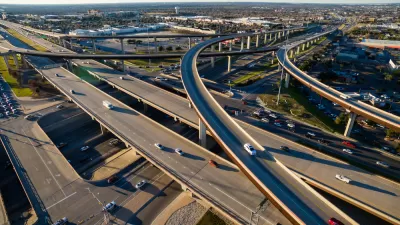One accurate measurement can be more insightful than a thousand expert opinions. In a recent blog titled, Livability and All That, highway expert Alan Pisarski argues that highway-oriented transport systems are necessary for efficient consumer and labor markets.
One accurate measurement can be more insightful than a thousand expert opinions.
In a recent blog titled, Livability and All That, highway expert Alan Pisarski argues that highway-oriented transport systems are necessary for efficient consumer and labor markets. In Highways and Labor Markets, fellow Planetizen blogger Michael Lewyn challenged Pisarski's assumptions by pointing out that residents of walkable and transit-oriented neighborhoods generally have better overall access to goods, services and jobs than in automobile-dependent spawl, and that Atlanta (Pisarski's example of an automobile-dependent city) is no more economically successful than more multi-modal cities.
Let me add some hard data to this debate. The figure below shows the relationship between per capita vehicle travel and GDP for major U.S. urban regions. It indicates that regions where people drive less tend to be more economically productive.
Figure 1 Per Capita GDP and VMT For U.S. States

Per capita economic productivity increases as vehicle travel declines. (Each dot is a U.S. state.)
Figure 2 shows the relationship between roadway lane miles and GDP. It indicates that regions with less roadway supply tend to be more economically productive.
Figure 2 Per Capita Road Lane Miles and GDP

Economic productivity declines with more roadway supply, an indicator of automobile-oriented transport and land use patterns. (Each dot is a U.S. urban region.)
Figure 3 shows the relationship between per capita transit ridership and GDP. It indicates that regions with higher transit ridership tend to be more economically productive.
Figure 3 Per Capita GDP and Transit Ridership

GDP tends to increase with per capita transit travel. (Each dot is a U.S. urban region.)
There is plenty of econmic theory to support the conclusion that multi-modal transportation systems support economic development more than automobile dependent transport systems. Travel demands are diverse: some goods and activities are accessed most efficiently by automobile, but others are most efficiently accessed by walking, cycling or public transit. As a result, an efficient transport system supports diverse mobility options and gives travelers incentives to use the most efficient mode for each trip, through efficient pricing of roads, parking, insurance and fuel.
Like most economic imputs, roadway investments can have deminishing marginal benefits. Although the first highways built in a region tend to provide large productivity benefits, once the basic roadway system exists, further expansion provides less incremental benefit. Figure 4 illustrates the result of a U.S. Federal Highway Administration study which indicates that, although highway construction provided very high return on investment during the 1950s and 60s, when the Interstate Highway System was connecting regions, economic returns subsequently declined, because the most productive projects (those linking regions) had been completed, leaving less productive links to be added.
Although that analysis did not continue to the following decades, it is likely that economic returns from highway expansion continued to decline.
Figure 4 Annual Highway Rate of Return (Nadri and Mamuneas 1996)

Highway investment economic returns were high during the 1950s and 60s when the U.S. Interstate was first developed, but have since declined, and are now probably below the returns on private capital, suggesting that highway expansion is generally a poor investment.
Automobile transportation is costly to governments (for roads), businesses (for parkling subsidies), consumers (to own and operate automobiles), and economies (to import vehicles and fuel). These are true resource costs which burden an economy. Automobile-dependent transport systems are particularly harmful to physically, economically and socially disadvantaged people who either cannot drive, or are significantly burdened by the financial costs of driving.
This is not to suggest that automobile transportation should be eliminated altogether, but it does indicate that transport policies that create more diverse and resource efficient transport systems do more to support economic development, provide more consumer benefit, and provide more economic opportunity to disadvantaged people than further highway expansion.
For More Information
Marlon Boarnet (1997), "New Highways & Economic Productivity: Interpreting Recent Evidence," Journal of Planning Literature, Vol. 11, No. 4, May 1997, pp. 476-486; also available as Working Paper 291, University of California Transportation Center, www.uctc.net/papers/291.pdf.
David J. Forkenbrock and Glen E. Weisbrod (2001), Guidebook for Assessing the Social and Economic Effects of Transportation Projects, NCHRP Report 456, Transportation Research Board, National Academy Press (www.trb.org).
Piyapong Jiwattanakulpaisarn, Robert B. Noland, Daniel J. Graham and John W. Polak (2009), "Highway Infrastructure And State-Level Employment: A Causal Spatial Analysis," Papers in Regional Science, Volume 88 Number 1, pp. 133 – 159; at http://ideas.repec.org/a/eee/transa/v44y2010i4p265-280.html.
Andreas Kopp (2006), Macroeconomic Productivity Effects of Road Investment: A Reassessment for Western Europe, Transportation Research Board 85th Annual Meeting (www.trb.org); available at www.mdt.mt.gov/research/docs/trb_cd/Files/06-2210.pdf.
Todd Litman (2009), Are Vehicle Travel Reduction Targets Justified? Evaluating Mobility Management Policy Objectives Such As Targets To Reduce VMT And Increase Use Of Alternative Modes, VTPI (www.vtpi.org); at www.vtpi.org/vmt_red.pdf.
Todd Litman (2010), Evaluating Transportation Economic Development Impacts, VTPI (www.vtpi.org); at www.vtpi.org/econ_dev.pdf.
SACTRA (1999), A Framework for Assessing Studies of the Impact of Transport Infrastructure Projects on Economic Activity, Standing Advisory Committee on Trunk Road Assessment, Dept. of Environment, Transport and Regions (www.roads.detr.gov.uk); available at www.dft.gov.uk/stellent/groups/dft_transstrat/documents/page/dft_transstrat_504940.pdf.

Maui's Vacation Rental Debate Turns Ugly
Verbal attacks, misinformation campaigns and fistfights plague a high-stakes debate to convert thousands of vacation rentals into long-term housing.

Planetizen Federal Action Tracker
A weekly monitor of how Trump’s orders and actions are impacting planners and planning in America.

In Urban Planning, AI Prompting Could be the New Design Thinking
Creativity has long been key to great urban design. What if we see AI as our new creative partner?

Pedestrian Deaths Drop, Remain Twice as High as in 2009
Fatalities declined by 4 percent in 2024, but the U.S. is still nowhere close to ‘Vision Zero.’

King County Supportive Housing Program Offers Hope for Unhoused Residents
The county is taking a ‘Housing First’ approach that prioritizes getting people into housing, then offering wraparound supportive services.

Researchers Use AI to Get Clearer Picture of US Housing
Analysts are using artificial intelligence to supercharge their research by allowing them to comb through data faster. Though these AI tools can be error prone, they save time and housing researchers are optimistic about the future.
Urban Design for Planners 1: Software Tools
This six-course series explores essential urban design concepts using open source software and equips planners with the tools they need to participate fully in the urban design process.
Planning for Universal Design
Learn the tools for implementing Universal Design in planning regulations.
planning NEXT
Appalachian Highlands Housing Partners
Mpact (founded as Rail~Volution)
City of Camden Redevelopment Agency
City of Astoria
City of Portland
City of Laramie





























